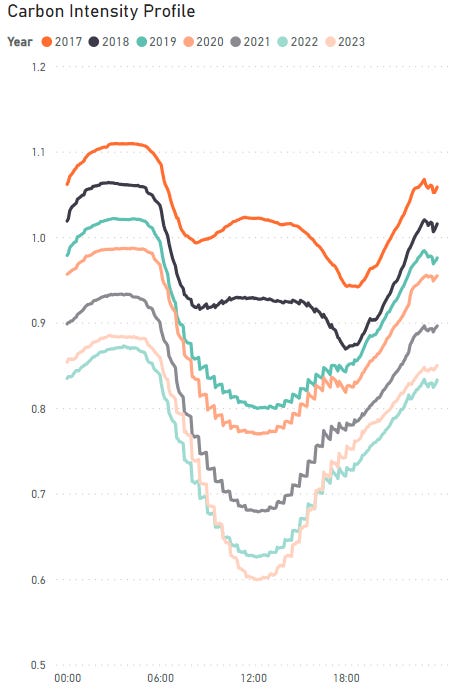Electric vehicles are a big deal. Over 10 million were sold last year. They have a key role in decarbonising transport. Road transport caused 91 millions tonnes of C02-equivalent emissions last year in Australia alone.
But how clean is it driving an EV? Obviously there are no emissions coming out of the tailpipe, so EVs are great at reducing urban pollution. The cleanliness of driving an EV then comes down to the cleanliness of the electricity used to fill up.
This is a fairly challenging question — what is the impact of a new electrical load on the emissions of the grid? If I turn on a light, run a heat pump, switch on an induction stove, or charge my car what increase in emissions did I cause? Is it “greener” in the middle of the day?
As I’ll get into, it’s not easy to clearly attribute an outcome to an individual action in a system as large and as complex as an interconnected power system. Taking the EV example, measuring its tyre tread (its carbon footprint, but specifically for cars — it’ll be cool to say this one day) is complicated, and the answer you’ll get depends on whether you focus on the immediate, or the longer term impacts.
With something as dynamic and evolving as the electricity system, arriving at exactly the right answer is actually not that helpful. Instead, knowing EVs are the future,1 the focus should be on how we can speed up the virtuous cycle of renewable energy and electrification.
And, yet again, I couldn’t think of an organic amusing through line, so let’s just go with millennial cult classic Napoleon Dynamite.
The emissions of an electric vehicle
Amongst all the reasons you should consider getting an electric vehicle now or in the future is that they are better for the environment. An EV substitutes a polluting combustion engine with a far more efficient electric motor.
Setting aside the difference in embodied emissions between the vehicle types for now,2 how much better is the electric vehicle? This is a question I’d imagine most EV buyers consider at some point. When you google it, you get a bit of a mixed bag. Mostly, affirmations that EVs are better than petrol and diesel cars. Occasionally, you’ll find some concerns about the impact of manufacturing batteries.
In my cursory googling, I didn’t find much discussion covering different ways of measuring the emissions linked with filling up an EV. There are a few different ways we can slice and dice it.
The easiest way - use your rooftop PV
The simplest way to avoid contemplating grid electricity emissions is to avoid using the grid altogether.
There is over 30GW of rooftop PV in Australia providing emissions-free electricity. Filling up an EV with rooftop solar is fantastic for the consumer, the grid, the planet and for closing this article and walking away. There’s no ambiguity here, every kilowatt hour that flows from a rooftop PV system to an EV in the same premises has zero emissions and gives the EV the ability to do mainies with a clear conscience.
Even with the best intentions, it’s pretty difficult to exclusively charge from your own rooftop solar. Most likely you’ll need to charge from the grid, either when you’re on the road or when the sun isn’t shining.
The standard way - annual averages of emissions intensity
This is the vanilla solution. It’s also how we measure carbon for the vast majority of grid electricity use (often referred to as scope 2 emissions).3 This methodology is used for measuring the emissions associated with grid electricity use for buildings, manufacturers, farms etc.
It’s also pretty simple. Take the average grid emissions intensity for the year and multiply it with the electricity consumed. The average grid emissions intensity just takes the total electricity-based emissions and divides it by the total electricity generated. Emissions factors are published by the Clean Energy Regulator (CER).
If your EV used 3,500kWh in Victoria (the dirtiest grid in Australia) in 2021-22, taking the CER emissions factor, you would have produced 3.36tCO2e for the year.4 This is actually higher than a standard internal combustion engine, which comes in at about 3tC02e. Of course, the big difference is that electricity is decarbonising. I’m not aware of petrol doing the same.
This approach to calculating electricity related emissions, while generally accepted, doesn’t account for the realities of an increasingly renewable power system. More and more renewable energy is being produced, but this doesn’t happen uniformly across the year. As a result, the dynamic grid-emissions intensity varies substantially from the annual intensity. Should this be reflected in how we measure the footprint of charging your car?
A harder way - dynamic measurement of emissions intensity
The carbon intensity of the grid is constantly changing.
As the graph below shows, the carbon intensity has fallen significantly over the years. It also varies hugely during the day. In reality, every minute of every day throughout the year will have different carbon intensities, rising and falling with the fluctuations in renewable energy and the dispatchable generators filling in the gaps.
From the perspective of an EV driver, this looks like an opportunity to charge up on lower emissions electricity. If you plug your car in during times where there’s lots of wind and/or solar, the electricity in the grid has substantially lower emissions intensity then the annual average.
If you used this approach and charged up your car in the middle of the day in Victoria (noting you’d have to look at every five minutes of EV charging side-by-side with the grid emissions intensity), you’d be able to come up with a new carbon footprint. If you charged from the grid around the middle of the day each day, you might arrive at ~2.3tCO2e, more than a 30% reduction in emissions.
Not so fast though. So far, we’re taking the grid emissions and assuming it stays the same for us when we switch on an EV. Like most things electricity related, its just not quite that simple…
The impossible way? — impact on marginal emissions
If you really wanted to get worked up about this, you could sit next to your car plugging and unplugging, wondering where that extra energy is coming from (or you could write a blog about it I guess).
So what really happens when you plug in your car and you charge it from the grid? Assuming all else remains equal, more power will flow through the poles and wires leading to your house, pulling down the voltage. As the balance between electrical supply and demand tilts, the power system frequency will fall ever so slightly. And far away from your garage, most likely a dispatchable generator will ever so slightly pick up the slack. This generator could be a battery or hydro, but it also could be coal or gas. So, potentially, you’ve just directly pushed up the generation of the dirtiest coal-fired power station in the country. Way to go.
This is the normal way to think about how a change impacts a system i.e., looking at the marginal impact. If you want to jump in an Uber in peak periods, you don’t pay the average price everyone else has paid throughout the day, you pay a higher price for the next car.
Several recent studies have looked at the impact of EVs on the marginal emissions of grids in North America and Europe. The Spanish study found that the emissions produced from EV charging under a marginal emissions methodology is nearly double that of the average emissions intensity (!!). Likewise in the US while average emissions have been decreasing the marginal emissions are actually increasing.
While it sounds counter-intuitive, the increase in emissions occurs because, as a battery charges in the middle of the day, the increase in load to charge to battery has to come from available dispatchable generators. Most wind and solar generators run at full generation whenever possible, so the additional energy to charge the battery comes from emissions intense coal generators. If the battery then discharges in peak periods, it typically displaces gas or hydro generation, resulting in a net increase in emissions.
Comparing utility scale batteries and EVs is like comparing lions and tigers. But if we’re thinking about the impact of charging your EV from the grid it is worth asking — is that extra energy typically dirty, even if the grid itself is on average clean?
Getting hung up on this question risks missing the forest for the trees.
The bigger picture
Marginal analysis of emissions might the best way to measuring the impact of demand management, but only over a short timeframe. Taking a few steps back, over longer timeframes there are strong positive links between smart charging of EVs and more renewables.
As we get more and more renewable generators, we see price cannibalisation. For example, most solar is competing with other solar, pushing down prices and reducing the business case for more solar. If we want to keep building wind and solar, we need to ensure there is enough electrical demand to use that energy. This is where charging EVs, batteries, pumped hydro and demand management come in.
If new electrical loads use electricity at low wholesale prices or times of low carbon intensity (which strongly overlap), it signals increased demand for electricity at these times. The energy buyers benefit because they’re accessing cheaper electricity. This also increases otherwise low electrical demand in renewable periods and strengthens the wholesale prices renewable generators receive.5 Thus a virtuous cycle is borne - batteries and EVs want cheap electricity → more load in low wholesale prices → increases wholesale prices → strong price signal to build more renewables → lower prices → more load…
In this case, the EV driver filling up from the grid is contributing to broader system wide trends that strengthen the opportunities for future renewables.
So, what’s the right way to measure the emissions of filling up my car?
Using annual averages of emissions intensity is not good enough. It does not account for the variability in grid emissions during the day. The alternative method of looking at the marginal emissions might be a fairer reflection of the impact in the very short term, but doesn’t reflect real world, long-term outcomes.
An academic answer is use a long-run marginal emissions intensity. The long-run marginal approach is a methodology developed to try and account for the feedback loop between demand management (as well as EVs and storage) and renewables investment.6 A recent study of the British grid found that the long-run marginal emission rate was the best measure of the long-term impacts of load shifting. The study also found that moving loads into periods of high renewable output had a positive influence on new renewables being added to the system.7 This data is now being published in the US.
The data resembles the changing carbon intensity of the grid discussed earlier. That is, looking at the grid-emissions intensity every five minutes, and matching this to energy use. This suggests using a dynamic carbon intensity is a good proxy for the long term impacts.
Does this actually matter?
An EV is better for the environment than a combustion engine. Exactly how much better depends on how you look at it. But, from the perspective of the grid, climate change and all that, the exact numbers are just an accounting exercise. What really matters are the actions we want to encourage and the outcomes we want to deliver. For an EV driver concerned about maximising their positive impacts on the energy transition there are some clear takeaways:
Changing from a combustion engine to an EV is a good move for the climate. Sure, there will be exceptions to the rule, but in aggregate this is true.
Charging a car from rooftop solar is great and should be encouraged as much as possible.
The more an EV is filled up from the grid at times of high renewables, the better it is. This could be because you specifically charge up when the grid is renewable, or because you charge up when wholesale prices are low.
More important than all of that?
P.S. After I’d written most of this post I found this related blog. It’s fantastic, and eats my lunch. Well worth checking out!
Origin
For all you poor souls who love your Rugba Leeg, tonight is State of Origin. I hope you’re Queenslanders. If you are, unfortunately, a New South Welshman like myself, you might prefer reading about a a different kind of Origin:
Things happen
Daniel Westerman has used the opening plenary of Australian Energy Week to warn that there is an urgent requirement to build additional capacity.
The Grattan Institute has released its Get Off Gas report. The report calls for state governments to set a roadmap for the phase out of residential gas consumption. Amen.
Neoen (the OG big battery company) has secured a contract with WAEMO to build a 4 hour battery to help manage the duck curve. Apart from being blessed with yet another duck graphic, this is the second underwriting contract for a long duration battery in a month.
Curious if anyone reading baulked at this statement. We’ve been pretty clear that we think hydrogen powered cars are bogus. Please comment if you think this is too much of an assumption — we can dedicate a blog to arguing why we treat it as a given.
Depending on which life cycle emissions analysis you read, internal combustion engine cars likely produce less emissions to manufacture compared to electric vehicles. Although, this is quickly made up when you compare the operation of the two car types.
Although the official calculation for scope 2 emissions also includes offsets purchased via traded certificates or other mechanisms.
Assuming you drive 20,000km at an efficiency of 0.175Wh/km.
Or, even better, these increasing capture prices for renewable generators helps improve the contracted prices negotiated with offtakers. The healthier this number is, the easier it is to get project finance and you see where this is going.
Defined as the change in carbon emissions relating to a unit change in electricity demand, where structural change in the electricity system is explicitly taken into account (i.e. demand-side interventions dynamically interact with power stations commissioning and decommissioning, and with system operation).
Gagnon, P, Cole, W, ‘Planning for the evolution of the electric grid with a long-run marginal emission rate’, iScience, 25.










Another excellent example of people way smarter than me say things I try to say and it making far more sense. Thanks Dekkers
Another good reminder Declan that average emission intensity factors over egg storage scope 2s. Which begs another question - should lower fcas contribute towards scope 2 calcs, even though its providing a service? Not all scope 2s are the same it seems.